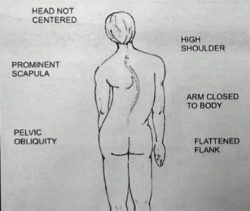August 2023
How Scoliometers are changing the Game
Scoliosis is a medical diagnosis that causes a 3-dimensional deformity of the spine as it curves and rotates to one side. This change to the spine can be mild or severe, gradual or quick and in some cases, it can cause pain, discomfort, and even difficulty breathing. To screen for scoliosis, there are a few standard tests that a doctor, nurse or physical therapist may use. The most common is the Adams forward bend test which is used in conjunction with a tool called a scoliometer to get a more precise understanding of whether the curve is in the scoliosis range of referral to a specialist. In this post, we’ll take a closer look at what scoliosis is, how it is diagnosed, and how a scoliometer is used in the diagnostic process.
What is Scoliosis?
As mentioned, Scoliosis is a 3-dimensional collapse of the spine that has a component of shifting, flexing and rotating of the curve as it tries to compensate to keep the body upright. This can happen in any part of the spine, but it is most common in the right upper back or the area between the shoulder blades. Scoliosis can be caused by a variety of factors, including genetics, uneven muscle development, or a birth defect but most of cases are considered idiopathic as they have no clear causative factor.
Symptoms of scoliosis can include:
– A visible curve in the spine (upper or lower) when bending forward
– Uneven shoulders or hips
– One shoulder blade that is more prominent than the other
– Back pain or discomfort
– Difficulty breathing
– Flat back

Diagnosing Scoliosis
To diagnose scoliosis, a doctor or scoliosis-certified physical therapist will perform a physical exam and may also use tools such as an X-ray or a scoliometer to determine a diagnosis. During a physical exam, the patient will be asked to bend forward to see if the spine curves more prominently in that position. We also look for signs of scoliosis, such as a visibly curved spine, uneven neck, shoulders, uneven hips and/or waist.
If scoliosis is suspected, an X-ray to get a better view of the spine will be ordered. When X-rays are measured at the upper and lower edges of the curve, this is called the Cobb angle. The degree of curvature and the age of the individual all help the doctor decide on the best course of treatment.
Using a Scoliometer
A scoliometer is a handheld tool that has a bubble in the center (like your standard handy level) that helps to measure the degree of curvature in the spine as it moves off center. The scoliometer is placed on either side of the spine, starting at the neck, while the patient is asked to bend forward as the tool is run down the spine.





The scoliometer measures the angle of curvature in degrees. The measurements can be taken from different angles and positions to get a complete picture of the spine’s curvature.
A scoliometer is a useful tool because it provides an objective measurement of the amount of rotation of the spine. This has a direct correlation with the Cobb angle without having to see an X-ray. The rotation of the spine is one factor that can help determine the most appropriate course of treatment for scoliosis, whether it be physical therapy, bracing, or surgery.
In conclusion, scoliosis is a 3- dimensional postural asymmetry that causes the spine to curve and rotate to the same side while the spine above and below are forced to compensate in the opposite directions. It can be diagnosed using a variety of tools including the scoliometer. A scoliometer is a handheld tool that allows us to measure the degree of spinal rotation in the spine objectively. If you suspect that you or a loved one may have scoliosis, it is important to see a doctor or your specialized scoliosis physical therapist for a quick and easy evaluation and diagnosis.


